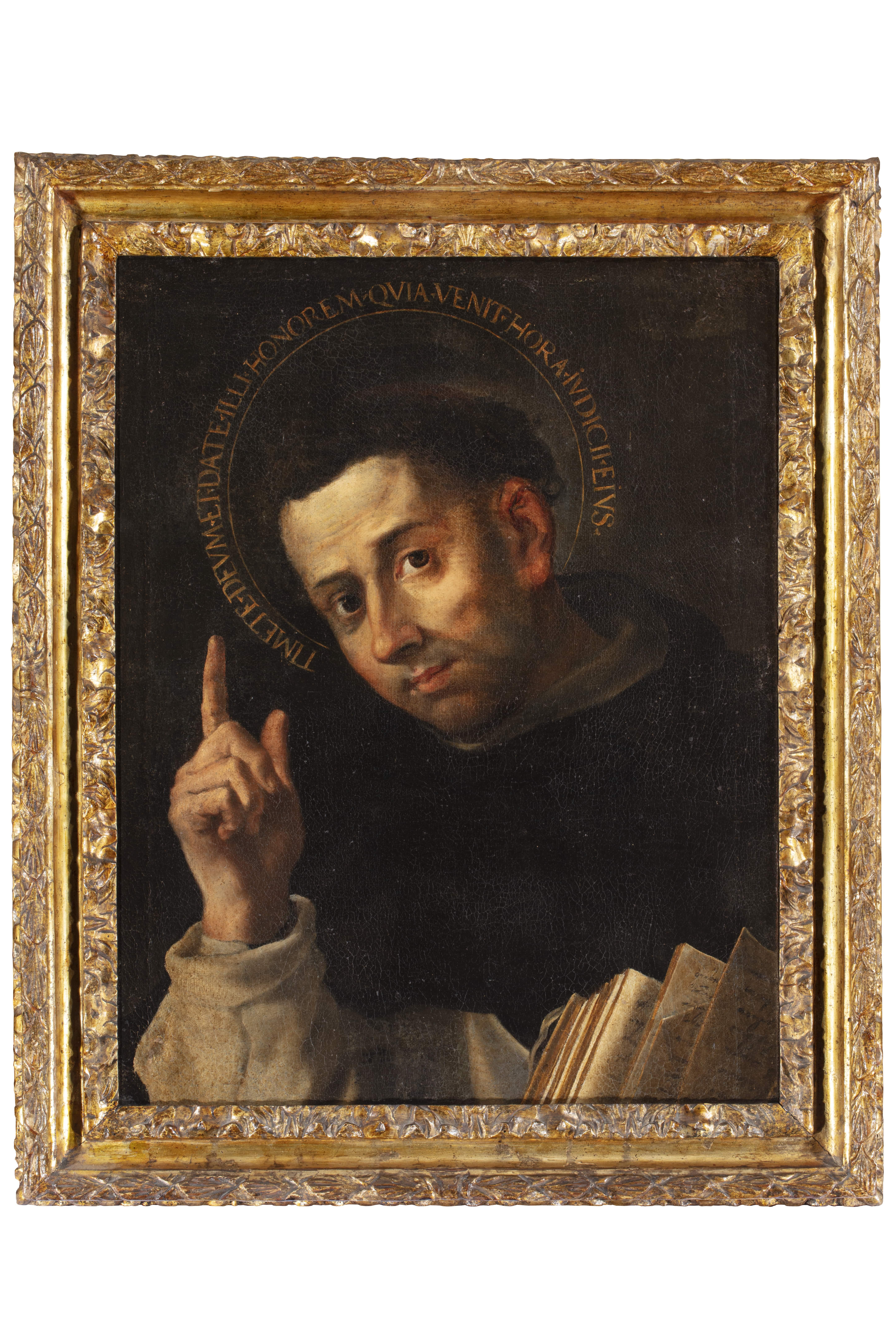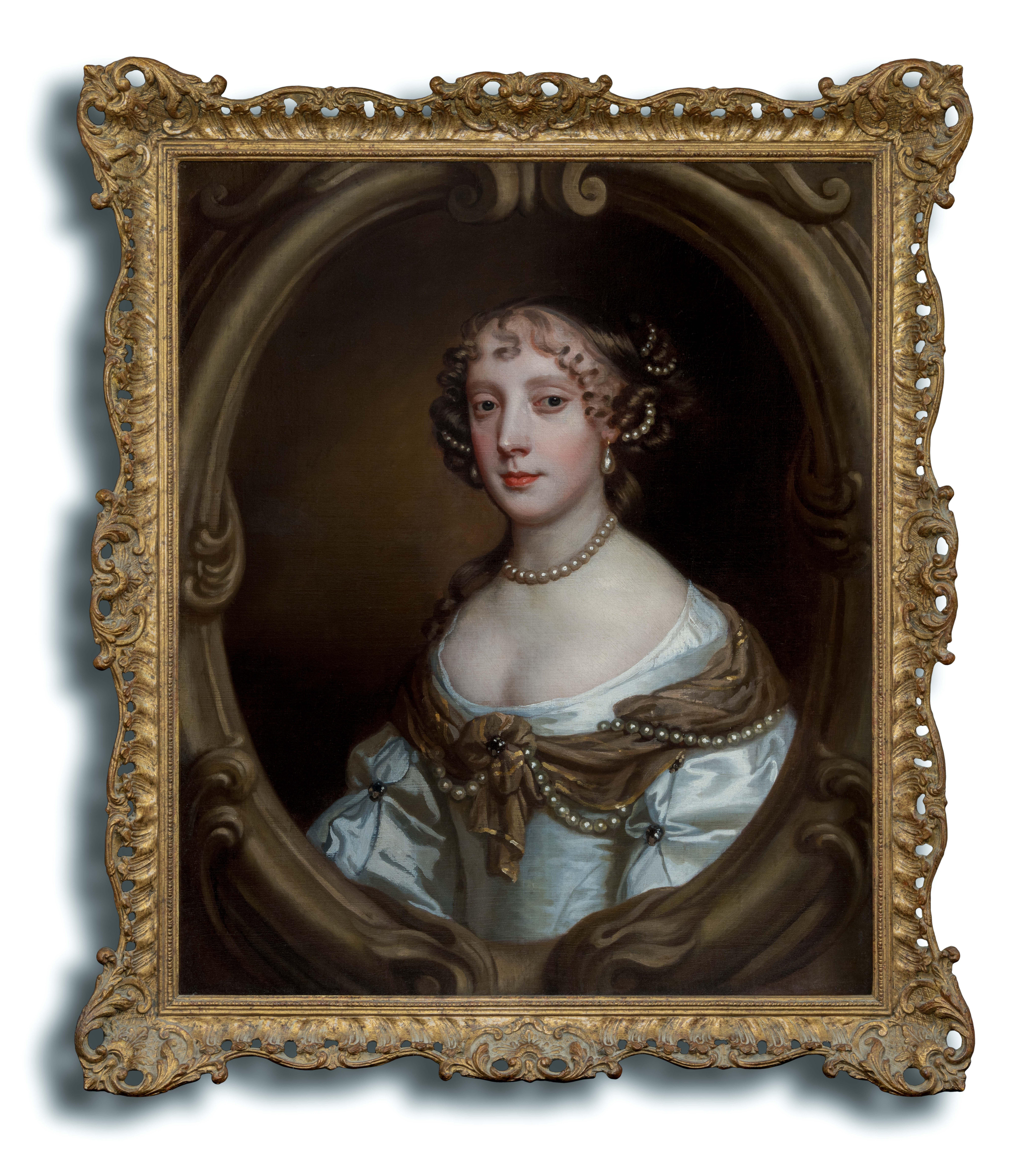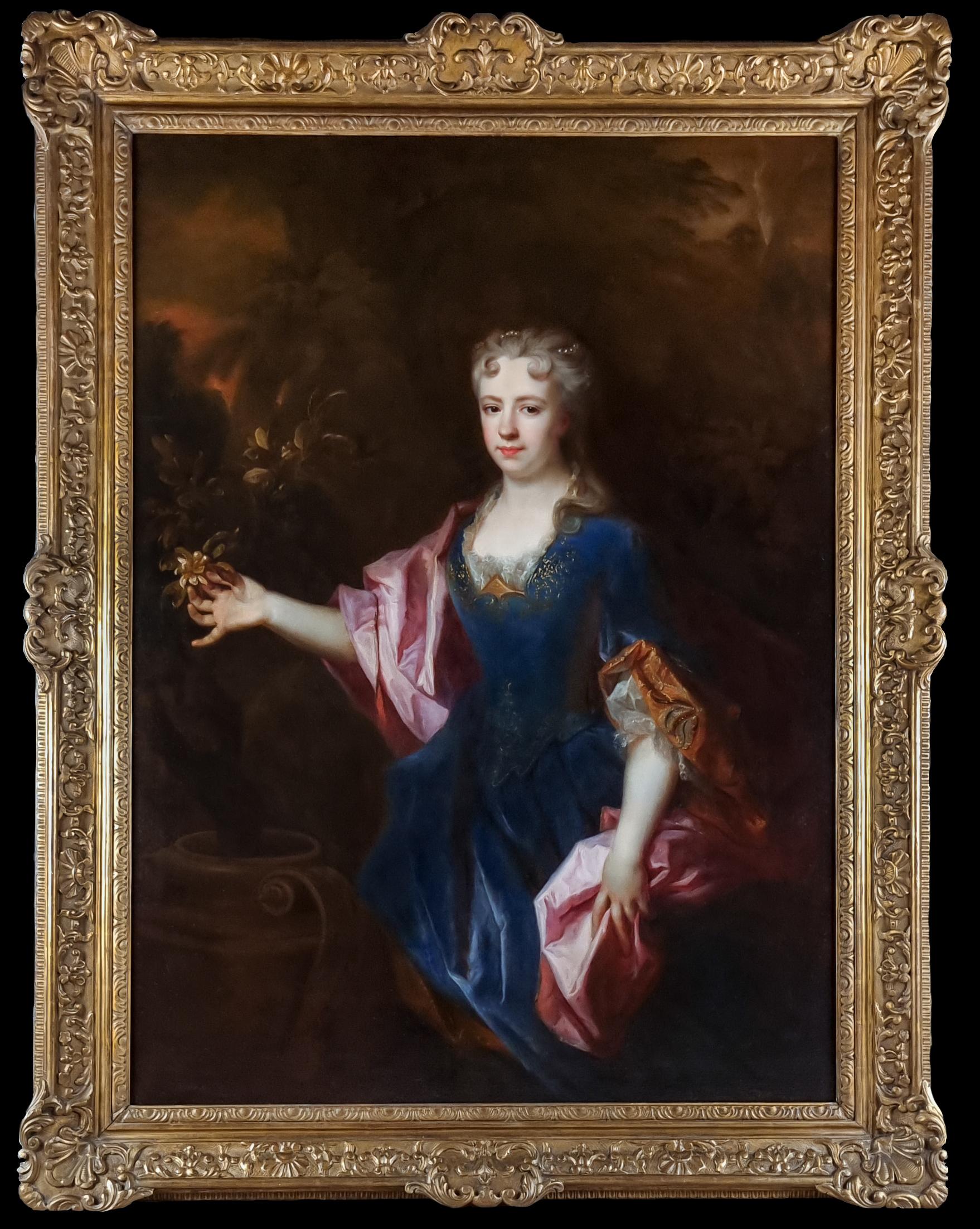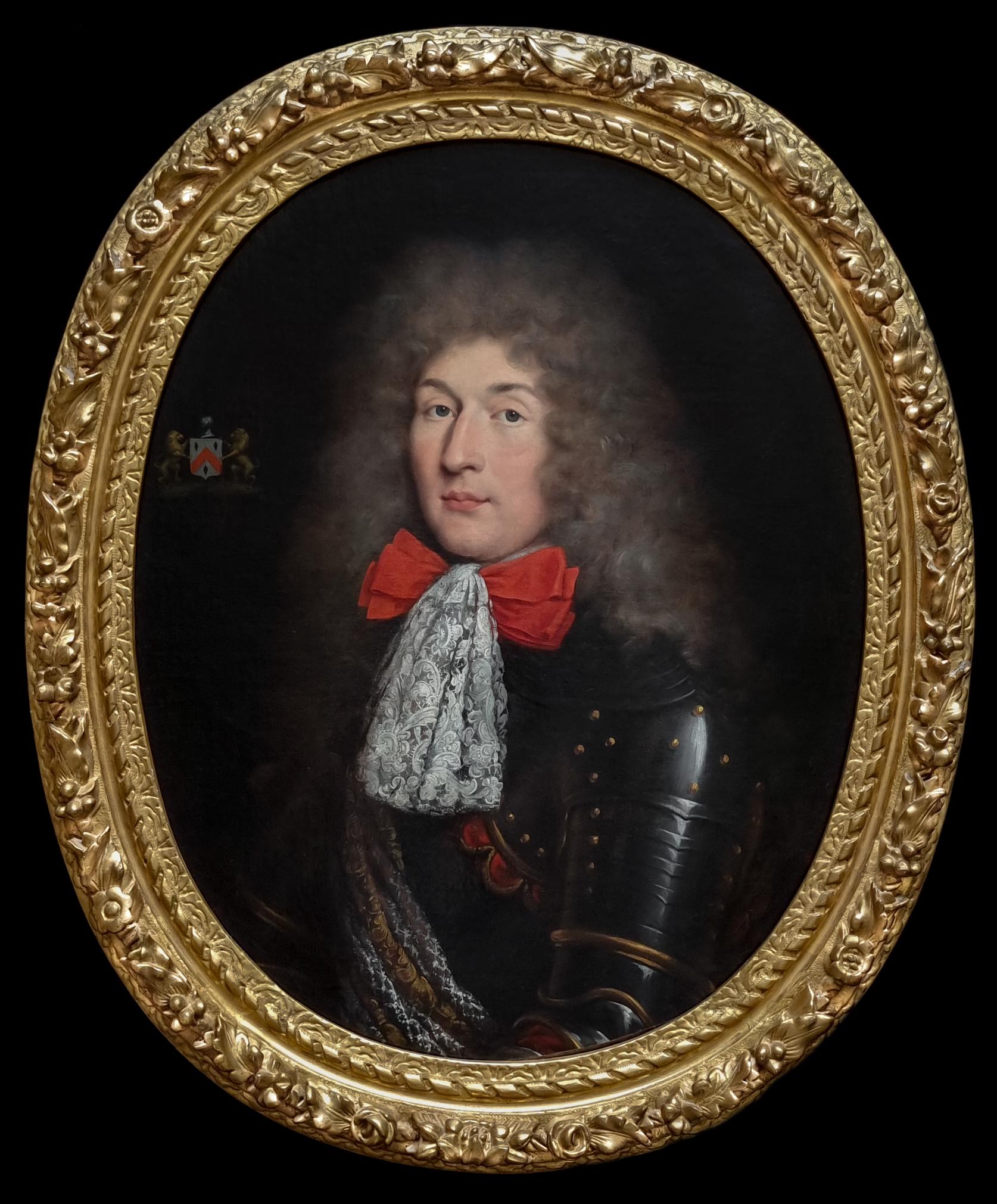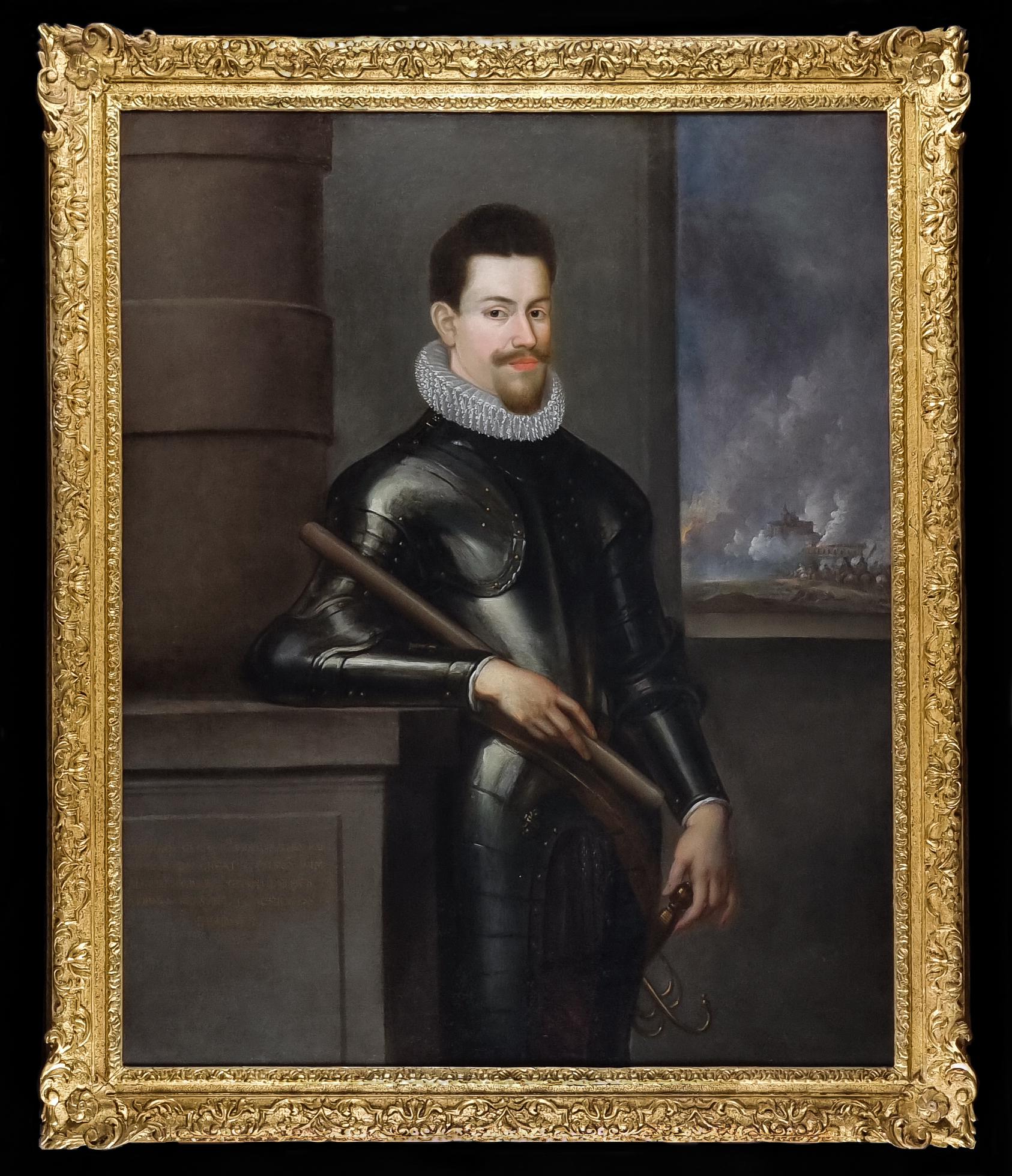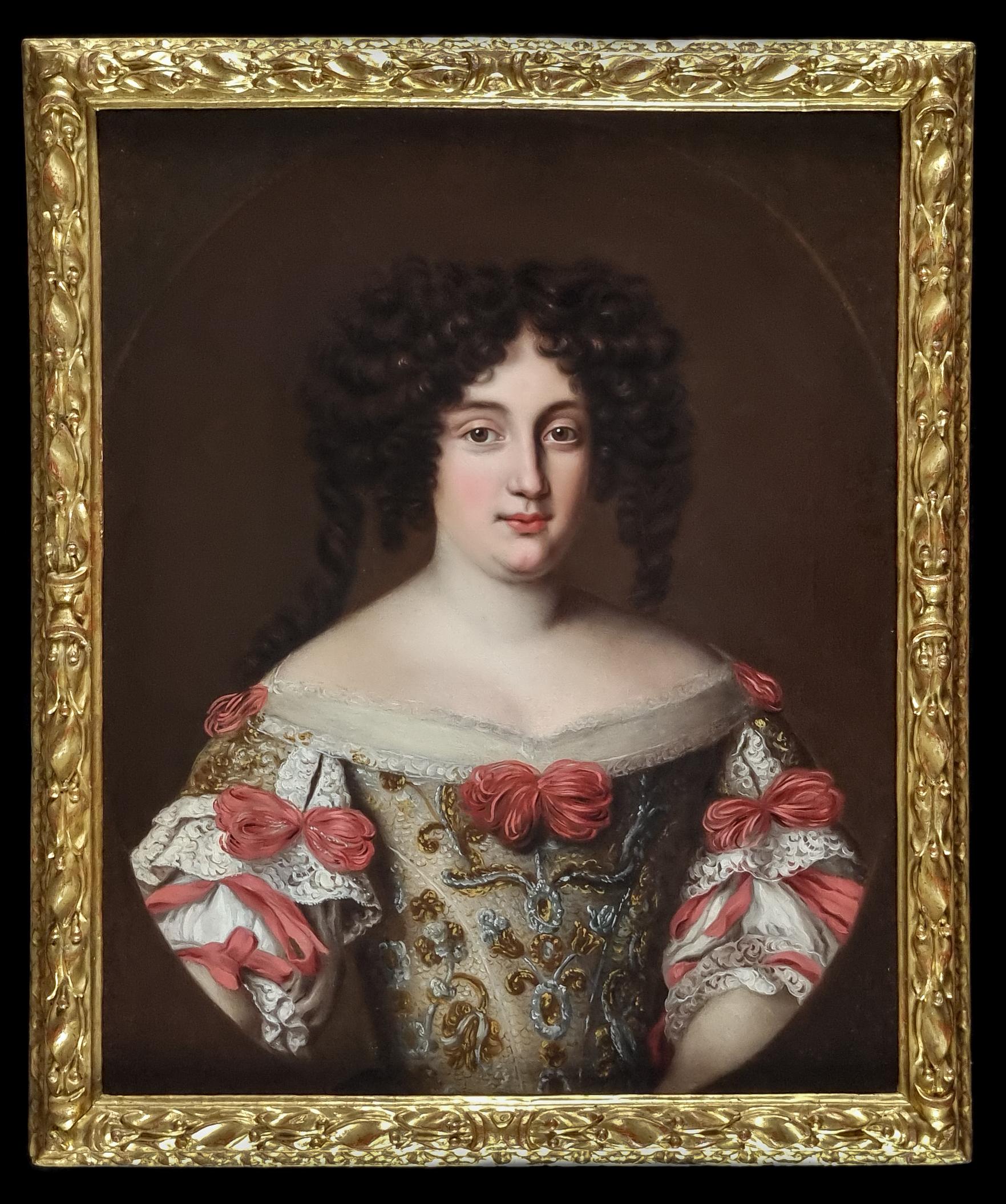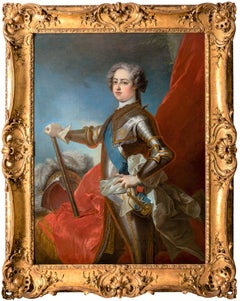
17th c. French school, French Princess Marie-Louise d'Orleans, attr. P. Mignard
Want more images or videos?
Request additional images or videos from the seller
1 of 15
17th c. French school, French Princess Marie-Louise d'Orleans, attr. P. Mignardcirca 1680
circa 1680
About the Item
- Attributed to:Pierre Mignard (1612 - 1695, French)
- Creation Year:circa 1680
- Dimensions:Height: 57.09 in (145.01 cm)Width: 50.39 in (128 cm)
- Medium:
- Movement & Style:
- Period:Late 17th Century
- Condition:Very good original condition, cleaned and revarnished by our professionnal art restorer.
- Gallery Location:PARIS, FR
- Reference Number:1stDibs: LU2433212156282
About the Seller
No Reviews Yet
Vetted Seller
These experienced sellers undergo a comprehensive evaluation by our team of in-house experts.
1stDibs seller since 2023
More From This SellerView All
- 18th c. French Portrait of Princess of Bourbon as Hebe, Pierre Gobert, c. 1730By Pierre GobertLocated in PARIS, FRPortrait of Princess of Bourbon as Hebe Pierre Gobert, circa 1730 Presumed portrait of Elisabeth Thérèse Alexandrine of Bourbon-Condé, Mademoiselle de Sens, depicted as the goddess Hebe kidnapped by Zeus, transformed into an eagle. 18th century French School, around 1730 Pierre Gobert (1662-1744) and workshop Oil on canvas Dimensions: canvas: h. 129 cm, w. 95cm Dimensions: framed: h. 156 cm, w. 124cm Louis XIV style giltwood and cardved wood frame Large and imposing portrait of the young princess portrayed seated on an eagle in the heavens. Seen from the front, the princess is dressed in a low-cut white chiffon dress, exposing her throat. Delicately made-up oval face, dominated by large blue-gray eyes is surrounded by powdered hair, raised, releasing the forehead and the ears, and of which some locks fall on his shoulder. A large blue scarf passed over the shoulder covers her knees and flies in the wind. A garland of flowers coming from the back goes over the knees and down again on the eagle. In her right hand she holds a golden goblet and in her left hand an ewer. The eagle supporting the young woman seizes in its claws the thunderbolt (the beam of fiery lightning), the attribute of Zeus. The figure of the young woman is enlivened by the fluidity of the antique drapes...Category
Early 18th Century Old Masters Portrait Paintings
MaterialsCanvas, Oil
$23,665 Sale Price20% Off - French, circa 1730 Portrait of King Louis XV in armour, workshop of J.B. Van LooLocated in PARIS, FRPortrait of French King Louis XV (1710-1774) in armour 18th century French school Workshop of Jean Baptiste Van Loo (1684-1745) Circa 1730 Oil on canvas, dimen...Category
Early 18th Century Old Masters Portrait Paintings
MaterialsCanvas, Oil
$29,800 Sale Price20% Off - 18th c. French Portrait of a Lady as Venus, attributed to Pierre GobertBy Pierre GobertLocated in PARIS, FRPortrait of a Lady as Venus ATTRIBUTED TO PIERRE GOBERT (1662-1744) FRENCH SCHOOL AROUND 1720 OIL ON CANVAS: H. 55.51 in, W. 42.91 in. IMPORTANT 18TH CENTURY GILTWOOD FRAME (RE-GILT)...Category
Early 18th Century Old Masters Portrait Paintings
MaterialsCanvas, Oil
$29,800 Sale Price20% Off - 18th c. French, circa 1725, by François de Troy, portrait of a Lady as CeresLocated in PARIS, FR18th century French School François de Troy (1645 – 1730), Paris, circa 1725 Portrait of a Woman as the Goddess Ceres Oil on canvas: h. 39 in, w. 31.3 in Regen...Category
Early 18th Century Old Masters Portrait Paintings
MaterialsCanvas, Oil
- 18th c. French Portrait of a Lady by Jean Ranc (1674 - 1735), Paris circa 1700Located in PARIS, FRPortrait of a Lady with carnations By Jean Ranc (Montpellier 1674 - Madrid 1735), circa 1700 Oil on canvas in oval shape, Dimensions: h. 35.82, w. 28.34 in. Period Louis XIV giltwood and carved frame with laurel leaves. Framed dimensions: h. 42.52 in, w. 33.85 in. Provenance: Collection of the Marquis de Bailleul at the Château d'Angerville-Bailleul (before 1942). To be included in the catalog raisonné of the artist by Stephane Perreau Important portrait of a young woman depicted half-length turned three-quarters, her face looking at the viewer. Dressed in a brick red velvet dress, an elegant blue scarf envelops her figure. Hair styled “a la Fontange”, her powdered hair is raised and tied at the back with a red ribbon, several curly locks escape from her bun and fall on her back and shoulders. The perfectly oval face with regular features dominated by her straight nose is softened by her gray eyes with slightly lowered lids. The red tinged skin tones on the cheeks and cheekbones color the face and make the portrait come alive. The young woman is portrayed standing near a pot of carnations. Her strongly lighted figure stands out against an architectural background of columns. The artist's palette is made of contrasts opposing warm to cold hues. The icy electric blue contrasts with the fiery brick red, the hair powdered with white accentuates even more the flush of the cheeks. The left arm bent at the elbow, extending the open hand with slightly bent fingers in the foreground brings depth to the composition. Our portrait, an interesting testimony in the corpus of works of the painter, is part of his youthful period, around 1700-1705. The former belonging of this portrait to the Marquis de Bailleul reinforces the remarkable character of our painting. The portrait has been examined by Stéphane Perreau, specialist of Jean Ranc and will be included in the catalog raisonné currently being written, under number P. 43. The notice edited by Mr Perreau is below: "Painted around 1700-1705, this portrait of a woman is directly inherited from Hyacinthe Rigaud, the master of Jean Ranc (the hand turned over the front, in a watch...Category
Early 18th Century Old Masters Portrait Paintings
MaterialsCanvas, Oil
- Portrait of count Evreux, French, 18th c. studio of Hyacinthe Rigaud, circa 1705By Hyacinthe RigaudLocated in PARIS, FRPortrait of Henri-Louis de la Tour d'Auvergne, Comte d'Evreux Studio of Hyacinthe Rigaud (1659-1743) Early 18th century French school, circa 1705 Oil on canvas Dimensions: h. 72 cm, w. 57.5 cm Louis XIV period gilded and richly carved wood frame with flowered corners. Framed: h. 96 cm, w. 80 cm Henri-Louis de la Tour d'Auvergne (1679-1753), Count of Evreux at the age of 24. The young man is depicted standing, seen at mid-height, turned three-quarters, against a background of a sky filled with cannon smoke. Head turned to the left, a large wig falling over his shoulders, a youthful face with plain cheeks, a delicate smile from thin lips, a gentle, benevolent facial expression. The right hand rests on the command staff in the foreground, while the left arm is bent and the hand rests on the hip. He is wearing a white sash of command, the floating drapery of which appears to his right. Fully armored, his only visible adornments are the blue velvet facings at the joins of the armor pieces and the sleeves of fine white lace. Power and charisma emanate from this military portrait. The young man's stature, bearing and head carriage convey the image of a valiant warrior. The theatrical lighting abundantly illuminates the face and creates strong metallic reflections in the armor. Despite his static stance, the hair blowing in the wind enlivens the painting, lending a dynamism and vigor that amplify the model's belligerent attitude. Our work is a studio version by Hyacinthe Rigaud, the original of which was executed by the artist himself in 1703. This original portrait of the Comte d'Evreux is now housed in the Gemälde Galerie - Alte Meister in the collections of the Kassel Museum. This portrait, one of the artist's most successful, was exhibited in 1704 at the Salon de l'Académie des Beaux-Arts and received rave reviews. As for the Compte d'Evreux, as soon as the original was created, he was satisfied with the artist's work and directly commissioned several replicas, which were executed by the studio between 1703 and 1705. These studio versions, as in the case of our painting, were intended as gifts from the Count to his wartime companions or members of his family. Our work is listed in the catalog raisonné of Hyacinthe Rigaud written by the artist's specialist Mr. Stéphane Perreau (published in 2004) Provenance: former private collection in Dijon, Burgundy Henri-Louis de la Tour d'Auvergne, le comte d'Evreux was the fourth son of the Duc de Bouillon, Godefroy-Maurice de La Tour...Category
Early 18th Century Old Masters Portrait Paintings
MaterialsCanvas, Oil
You May Also Like
- 17th century By Neapolitan maestro San Vincenzo Ferreri Oil on canvasLocated in Milano, Lombardia“Timete Deum et date Illi honorem quia venit hora iudicii Eius” (Fear the Lord and honour Him, for the hour of His judgement has come): the passage from John's Apocalypse (chapter 14...Category
17th Century Old Masters Portrait Paintings
MaterialsCanvas, Oil
- 16th Century by Bernardino Detti Face of Christ Oil on CanvasLocated in Milano, LombardiaDimensions: 41 x 32 cm without frame - 47 x 55.5 cm with frame Antique box frame made of solid wood and walnut burl. Publications: unpublished The painting by Bernardino Detti (14...Category
16th Century Old Masters Figurative Paintings
MaterialsCanvas, Oil
- Portrait of Lady, Grace Saunderson, Viscountess Castleton Oil on canvas PaintingBy Studio of Sir Peter LelyLocated in London, GBPortrait of Grace Saunderson, Viscountess Castleton (1635-1667) c.1665-67 Sir Peter Lely and Studio (1618-1680) Titan Fine Art present this work, which formed part of a collection of family pictures and heirlooms of the Saunderson, Viscount Castleton family and their descendants, the Earls of Scarbrough, at their magnificent family seat Sandbeck Park, where the Earls still reside today almost four hundred years later. It was painted in the studio of Sir Peter Lely...Category
17th Century Old Masters Portrait Paintings
MaterialsCanvas, Oil
- Portrait of a Lady in an Elaborate Stone Cartouche, Oil on canvas PaintingBy Mary BealeLocated in London, GBPortrait of a Lady in an Elaborate Stone Cartouche c.1675-80 Mary Beale (1632-1699) Titan Fine Art present this superb portrait where the sitter has been portrayed wearing a low-cut white chemise under a gold silk robe with a draped light...Category
17th Century Old Masters Portrait Paintings
MaterialsCanvas, Oil
- Portrait of a Lady, Marie-Madeleine de Chamillart, Oil on Canvas PaintingLocated in London, GBThis work formed part of the collection of paintings and family heirlooms of Baron Hugues Alfred Frèdéric de Cabrol de Moute (1909-1997) and his wife, Baroness Marguerite (née d’Harcourt) de Cabrol de Moute (1915-2011). The couple had unimpeachable and enviable family backgrounds, and were descendants of ancient princelings; together they were one of the most prominent high-society couples of the twentieth century and counted the Duke of Duchess of Windsor amongst their closest friends. This portrait is that of Marie-Madeleine de Chamillart (died 28 May 1751) nee Nicolas de Lusse. She had a daughter, Anne, in 1692. In 1700 she married Clément Chamillart (1663-1708), President of the Accounts of the King's Chamber. The couple had a daughter, Madeleine (born 1701), who married Louis, the only son of Guillaume de Guitaut and Antoinette de Vertamont in 1719. Guillaume de Guitaut resided at Château d'Époisses in Burgundy France and his descendants still live today. A portrait of our sitter is still held at the Château. Clément Chamillart died in 1708 and our sitter remarried Jean-Baptiste de Johanne de la Carre (1678-1726), marquis de Saumery, maréchal de camp, in 1713. This marriage produced two daughters, Marguerite (died 1729) and Marie Madeleine (born 1720). Much of the beauty of this elegant portrait resides in its graceful composition – it is a fine example of French portraiture. Beautifully and meticulously rendered throughout, the sitter has been depicted three quarter length in an outdoor setting beside a potted orange tree. The lady is shown in a blue dress with silver detailed décolletage and large voluminous sleeves turned over to reveal elaborately detailed lining. The sumptuous fabrics convey a sense of wealth and prestige. The portrait is striking in its portrayal of the sumptuous fabrics and their decorative richness. The prominent sprig of orange blossom that she is holding is a traditional representation of marriage and eternal love in art, but it also alludes to youth and freshness, and by virtue of the great expense and difficulty with which it was often grown, to great wealth. In accordance with the sitter's age and the style of clothing and hair with the curls on the forehead, this portrait can be dated to the 1720s. Baron Hugues Alfred Frèdéric de Cabrol de Moute (1909-1997) was the son of Roger de Cabrol de Moute and Helen Mary de Lassence. He was one of the more engaging personages in that delightful social constellation of social figures who animated what has become known as "Cafe Society" which was international but inevitably most at home in Paris from the 1920's until the 1960's. He married Marguerite d'Harcourt (1915-2011), known as Daisy, in Paris in 1937, the only daughter of Étienne, Marquis d'Harcourt, and his wife, Marie de Curel. The Harcourt family belongs to the circle of the oldest families in France; the founder of the family, Bernard le Danois, received the seigniory of Harcourt in the tenth century, following the conquest of Normandy. In the 11th century, his descendants took part in the conquest of England alongside William the Conqueror. Later, the Harcourt family was divided into a French branch and an English branch, which successively received the titles of barons, viscounts, and counts. Marguerite "Daisy" Marie Brigitte Emmanuelle Ghislaine d'Harcourt, Baronne de Cabrol was one of the last survivors of twentieth century French high society. Through her mother, Daisy was a descendant of the great industrial family of Wendel, with iron and steel enterprises in Lorraine; she also descended from Nicolas Soult, one of Napoleon's Marshals and three times Prime Minister of France. The couple became friends of the Duke and Duchess of Windsor in 1947, and were invited to the Chateau de la Croë, their rented house on Cap d'Antibes. There they found the exiled Windsors living in unusual post-war luxury, serving delicious food and providing fresh sheets every day. Daisy suspected that the Windsors were bored, but, having nothing else to do, were condemned to an endless round of social engagements. She and Fred were among the few allowed to see the Duchess laid out after her death in 1986. Daisy was a considerable hostess, giving a ball every year for her charity, L'Essor, to which le tout Paris would come. One of these, in 1954, was at the Palais des Glaces, in Paris (later used in the film Gigi), at which she entertained Charlie Chaplin, the Begum Aga Khan and the Windsors. According to Nancy Mitford...Category
18th Century Old Masters Portrait Paintings
MaterialsCanvas, Oil
- English Portraits of Lady, Dorothy & Jane Wood c.1750, Remarkable Carved FramesBy John Theodore HeinsLocated in London, GBPortraits of a Lady, Dorothy and Jane Wood c.1750, Fine Carved Frames By John Theodore Heins (1697-1756) Titan Fine Art present these works, which formed part of a collection of family heirlooms of the Wood family who were from Bracon Ash, Norfolk, since the medieval period. Jane’s daughter Ann, was famously married on board the Foudroyant, off Naples, in a lavish ceremony in 1799, with Lord Nelson himself giving away the bride. The paintings descended within the family for around 275 years until recent and are exquisite examples of Georgian portraiture in England and are some of the best works by the artist. The original hand carved and gilded pierced frames are magnificent works of art in their own right. The sitters were two children, out of several, of Thomas Wood (1682-176) and Dorothy Huby (1700-1759). The family is from Norwich, which in 1720 was a city second in importance only to London. Their aunt, Jane Wood (1677-1756), was a Franciscan nun in Bruges. Dorothy Wood (in the blue dress) was baptised 2nd June 1726 and she died unmarried around 1759. Jane (in the pink dress) gave birth to at least six children during her thirty two-year marriage. She was baptised 14 Oct 1727 at Bracon Ash. Jane married Knipe Gobbet (1730/5-1791) who was Sheriff in 1768 (and Mayor in 1771) of the City of Norwich, and later Lieutenant-Colonel of the West Norfolk Regiment, in which corps he had served in for many years. According to Payne’s Universal Chronicle or Weekly Gazette the marriage took place on 7th July 1758. Knipe was born at his family seat, Tacolneston Hall, to parents George Gobbet, who was Sheriff in 1710, and Ann. The couple bought and lived in a house in Norwich (later known as Gurney’s Bank House) until 1778 before moving to another one at 10 St Stephen’s Street, Norwich. Later, they inherited the family seat of Tacolnestan Hall and lived there for the remainder of their lives. Knipe Gobbet was a prominent individual and in 1779 he gave the corporation of Norwich 100 pounds, to be disposed of as they might think proper, and soon after that he was presented with a handsome field tent, marquee, and camp equipage, in testimony of their esteem for his dedication to the defence and service of this country at a time when threatened by an invasion. Although Jane was baptised a Roman Catholic Knipe was a prominent local wine merchant, JP, Alderman, sheriff, mayor and Lieutenant. Roman Catholics may have paid lip service to religious conformity as they were excluded from certain areas of public life before the Catholic Emancipation Act of 1829. Such discrimination probably lies behind the why their children are included in the registers of both the Anglican church in Tacolneston and the Norwich Catholic church in the 1760s. Jane and Knipe had one son, Thomas, who died at the age of four of a small-pox inoculation in 1762 (memorial stones in the Church of All Saints, Tacolneston) and many daughters who were schooled at the Order of the Immaculate Conception of Our Lady, in Paris. Their oldest daughter, Anne (1760-1817) was born at Tacolneston Hall. She came to the convent 30 Sept 1774 and ten days later she went to Dames St Sacrament, Rue St Louis in Paris. Their second daughter, Dorothy (died suddenly of apoplexy 21st Nov 1813), came to the convent 19th July 1777 when she was 16 years old and returned to England 23 March 1779. Frances (baptised 22 Feb 1763) came to the convent 16th April 1772 when she was 9 years old and returned 29th May 1777 – however she returned again to the convent 16th May 1778 and left 15th Oct 1778 to return home again. She later married and her surname became Negri. Another daughter, Jane, is thought to have married Juan Manuel Martinez in 1784. There was also another daughter, Mary. The eldest daughter, Ann, first married Peter Bottalini of London 27 Oct 1783 at Tacolneston Hall. They had one son together. She then married on 9th July 1799, Dr William Compton (1733- Clifton 1824), the Chancellor of Ely and the next collateral male relation to the Earl of Northampton (he had earlier marriages to Caroline and Catherine). William Compton later retired from the Commons and spent many years on the continent acting as Chancellor of Ely by proxy from 1777 for the remainder of his life. The couple were British residents of Posilipo Naples and the marriage was hosted on board the Foudroyant, off Naples, where the bride was given away by the Right Hon. Lord Nelson himself. The marriage document, signed by Lord Nelson, Lady Emma Hamilton, Captain Thomas Hardy, and others descended within the family, until sold in a sale that raised worldwide interest in 2023, for £20,160. The document is accompanied by a contemporary manuscript account of the wedding, headed 'Paragraph for the papers, sent to Messrs Coutts & Co with request to have it inserted'. Lord Nelson was a household name in Britain due to his many victories, including the Battle of the Nile against the French Navy in August 1798 – which came before the Battle of Trafalgar in 1805. The document states: 'This is to certify that, on board the Foudroyant lying in Naples Bay, on the ninth of July 1799 the marriage between William Compton & Mrs Anne Bottalin, widow, was solemnized by me S. G. Comyn HM. Chaplain to the Right Honble Lord Nelson, H.M.S. Foudroyant, in the presence of'. With the following autograph signatures: Sir William Hamilton (1731-1803), Lady Emma Hamilton (1765-1815), Horatio Nelson, Viscount Nelson (1758-1805); Sir John Thomas Duckworth (1747-1817), Sir Thomas Masterman Hardy (1769-1839), John Rushout, 2nd Baron Northwick (1769-1859), Josiah Nisbet (1780-1830), John Tyson, William Compton and Anne Bottalin, and 2 others” The document sheds light on Nelson's lesser-known side of his character. William Compton ... received "a great many favours and kindnesses" from Nelson, and most especially "the kind interest" taken in sealing his union with a wife who made him "the happiest of mortals". Anne, the aforesaid spouse, said that the admiral's "good heart" had made her "as happy as I can possibly be on this earth" ... Midshipman Parsons remembered those days nostalgically, noting Emma's "graceful form" bending over her harp to bestow "heavenly music" upon the diners on the quarterdeck and the large-decked galley, flush with opera singers, that glided alongside to serenade the sunset of each day'. Tacolneston has an ancient history of which according to the Domesday Book, Edward I granted a weekly market to be held on a Wednesday at the manor of Tacolneston and two annual fairs. The church was rebuilt in 1503 and is dedicated to All Saints. The earliest view of Tacolneston is a print of 1781 when it belonged to Knipe Gobbet Esq. John Theodore Heins (1697-1756) was a painter whose work, at his best, shows detail of an exceptionally high quality. His portraits of Anna Maria Kett nee Phillips and her husband Henry Kett, painted in 1741, are exceptional and evidence that he had the ability to portray a likeness on par with some of the best portraitists in England at the time. Heins appears to have originated in Germany but moved to the UK and settled in Norwich around 1720. From 1720 to his death in 1756, Heins built up a fine reputation as a portrait painter and painted many members of prominent Norfolk families right up to his last year. He was commissioned in 1732 to paint a portrait of the Mayor of Norwich, Francis Arnam and also the previous year's Mayor Robert Marsh...Category
18th Century Old Masters Portrait Paintings
MaterialsCanvas, Oil
